
As educators, we’re fortunate to have extended time each year to travel as a family. The very start of June, when school has just ended for us and before the nationwide summer crowds really get moving, has become our standard departure time. So as soon as the 2024 wall calendar was hung, we began another annual ritual: where would we travel this summer?
Why Visit Cartagena?
We spent an extended time away last summer in England and Scotland, which was amazing but ate up nearly our entire break together. (Colin is an 11-month employee and returns to work at the start of July.) So this year, we had a different set of criteria for travel, and Cartagena checked all the boxes.
- It’s easy to reach! Cartagena is a port city on Colombia’s northern coast. It’s about as far north as you can go in South America, further north even than the entirety of Panama, a North American country. So distance-wise, it’s not very far from our southeastern part of the US, and as a major tourist destination, there are numerous direct flights from New York, Miami, Atlanta, and Fort Lauderdale. Our flight from Nashville connected through Miami; each leg was about 2 hours. Can you find a quicker way to reach a different continent?
- Nashville and Cartagena share a time zone (Central), so no jet lag! Part of the reason last year’s trip to the UK was so long was because it feels necessary; you don’t want to spend a whole day traveling and two more acclimating to a new circadian rhythm just to leave three days later, especially when you’re slow traveling with kids. With these location advantages, Cartagena allowed us to spend all our time experiencing rather than adjusting.
- Cartagena’s history and culture is everywhere you look. It had been a long time since we challenged ourselves in travel. We wanted to visit somewhere we didn’t speak the dominant language, and our eldest daughter has a lot of interest and familiarity with Latin and South American culture. On the surface, Cartagena looks a lot different from home, and, deeper down, it has a lot of stories to tell. Our kids would be exposed to lives and communities that look different from their own, and the history we’d learn together would help them build their understanding of the world on a larger scale.
Where (and Where Not) to Stay
Old Town
The heart of Cartagena is a 16th-century walled “Old Town.” Here, you’ll find the narrow streets and colorful buildings that have come to define the city. This historic center is very much a bubble. While there are still some older-generation residents, much of the real estate has turned over to accommodate tourists. From a certain perspective, this could feel like Cartagena is just a curated destination, presenting a one-dimensional image of itself that meets a visitor’s expectations. To a degree, that could be true – think of New York’s Times Square or Paris’s Montmartre. But does that make these places unworthy of visiting? Of course not, because it’s always worth seeing with your own eyes, crafting your own experience and discovering the stories underneath.
Old Town is Cartagena’s tourist hub, and it’s always busy. In addition, cruises bring in a lot of day visitors. You can safely stay anywhere in the walled city, and there are MANY beautifully restored buildings with picture-perfect courtyards and rooftops. However, the southwestern part of the city center, close to the port and Monumento Torre del Reloj, has a lot more pedestrians, food carts, street vendors, and entertainers. It’s a fine area to stay, but you do risk a disco across from the street blasting pop music until 4am. For a quieter stay, head to the northeastern corner. We stayed across from Las Bóvedas at this wonderful 4-bedroom Airbnb in an apartment complex with 24/7 security and a downstairs bodega. There’s a primary school across the street and a fine arts college nearby, lending a more residential feel to the neighborhood. We also had easy access to the top of the wall, an artisan market, nearby shops and restaurants, and La Serrezuela mall.
Getsemaní
Another area of note is Getsemaní, a more bohemian neighborhood located just south of the walled city. Getsemaní is full of street art and tiny alleys, hostels and rooftop restaurants – a backpacker’s dream. It’s quieter and more residential but is fighting almost-imminent gentrification as development expands from the walled city and pushes out residents.
Bocagrande
Bocagrande is the last major area for tourists, and this is an area of high-rise white-towered apartments and hotels built in the 1980s (and still continuing through the present). Here you will find well-known international hotel chains and resorts with beach access and pools. It’s an okay spot to visit for a day as a kid-friendly break from the heat, but I don’t recommend making this your home base; it lacks the character and locality for which you came to Cartagena!
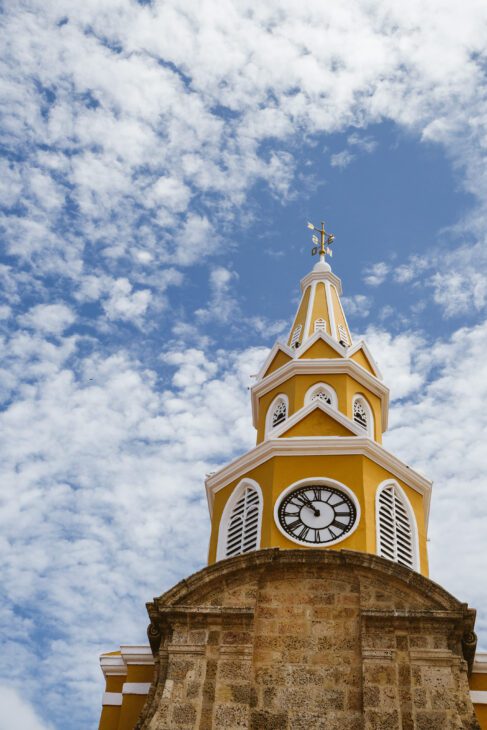
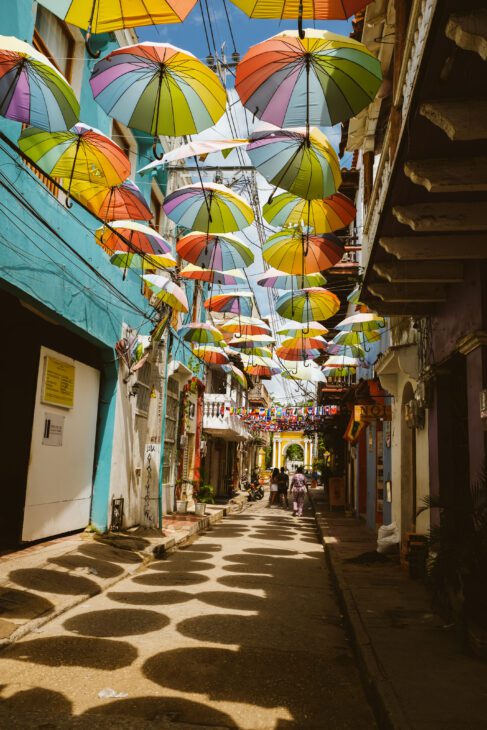
What Your Mom Wants to Know About Safety
Oh, are your parents also freaking out that you want to take your children to Colombia? Welcome!
I’m being facetious here in my writing, but I understand it’s a totally valid question and perspective. Within my lifetime, things once looked very different in Colombia with even Cartagena – a UNESCO World Heritage Site and longtime popular tourist destination – suffering fallout from drug wars of the 80s and 90s. That’s not the case today, especially in Cartagena where tourism has absolutely boomed in the last 20 years. Here’s some information I shared with my own parents:
We did a lot of research that led to our belief that Cartagena would be no less safe than any other major US or international city. It was named one of the top spots for travel in 2024 by Travel and Leisure, and the NYTimes did a 36-hour profile on the city just last summer. On top of anecdotal experience and reference from periphery people, I read more on the first-person experience from a couple of prolific internet travelers I have followed for years: here and here. Further, I did a lot of searching on “Cartagena with kids” and found ample blog posts and Reddit forums sharing guides and recommendations (examples here, here, and here).
Truthfully, we never ever felt unsafe in the neighborhoods I listed above. However, we do have fairly extensive experience traveling internationally. We’ve had countless experiences figuring things out amid language and cultural barriers, and we also have a decade’s worth of street smarts from living in NYC.
That’s not to say those are prerequisites for visiting Cartagena; it’s just that nothing was a surprise for us that we didn’t know how to handle. Yes, street vendors will approach you constantly, but please remember that as a tourist, you are this person’s main source of income. A firm but kind “no gracias” will usually suffice, but if you want to buy a drink or a tchotchke they’re selling, go ahead! I will say that I think being with young kids worked to our advantage and decreased the amount and persistence of solicitations we received; we felt a lot of respect towards the family unit. (Not a single street rapper approached us!) Also, the area we stayed was much quieter and we weren’t often out during the busiest late afternoon or later evening hours.
All that being said, many people do visit Cartagena with a different agenda in mind. Even with four kids in our party, we got offers for the “white coffee!” Just walk on and ignore, follow standard street smarts, and keep your wits about you. Lastly, I called the Old Town a bubble, because if you want to easily get “off-the-beaten path” for an “authentic” experience… well, Cartagena may not be the place for that. On our plane ride home, I chatted with a man from Cartagena who shared it’s very noticeable if you’re a tourist in a non-tourist area, and safety would be more of a concern. He believed travel outside the “tourist bubble” could be possible if you stuck with a local guide.
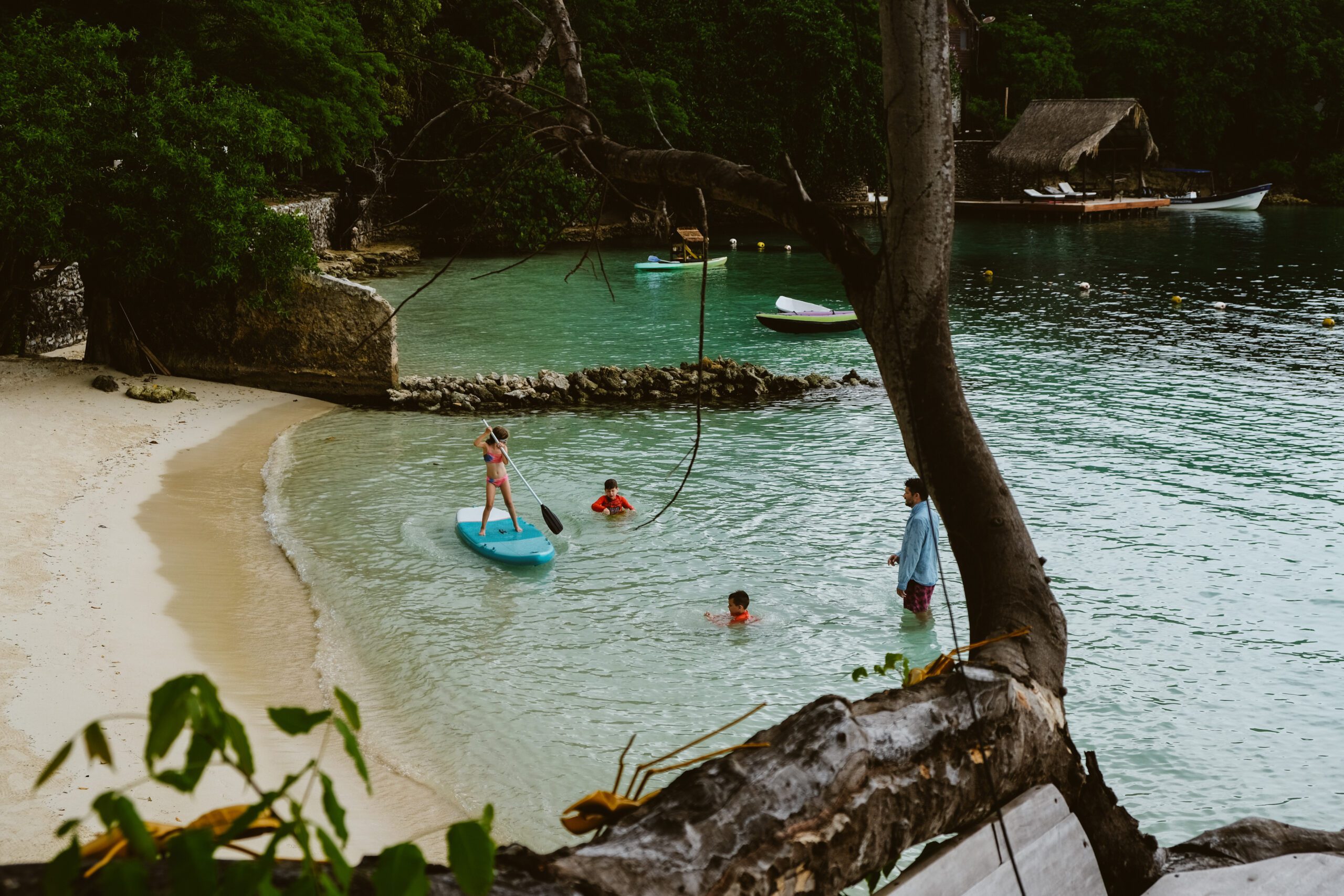
That 🥵 Caribbean Weather
As Cartagena is located on the Caribbean Sea, it has pretty consistently hot, topical weather. (A total contrast, apparently, to Colombia’s cooler climates in the mountains.) Peak season to visit is December through February when humidity is less intense. Rainy season starts with summer, from May to November, and is especially so towards the end. Though this season has more cloud cover throughout the day, most rain comes in sporadic afternoon showers.
For our visit in early June, it wasn’t the heat that was brutal as much as the humidity. I’m talking punch you in the face, immediately sweating, get used to being sticky-type humidity. Every time we walked out the door of our Airbnb, our glasses and camera lenses fogged up. (Keep a lens cloth in your bag!) It’s a draining feeling, but you also get used to it after being outside for a while. Expect to take lots of showers! For your accommodations, air conditioning is a must, for the humidity alone, and a pool is a much-appreciated bonus.
Must-Pack Weather Survival List
- Linen, athletic, and/or loose-fitting clothing (whatever you can sweat in)
- Sunglasses
- Hat to shield sun
- Umbrella for spontaneous downpours
- Swimwear and any necessary kids accessories (goggles, etc.)
- Good walking shoes
- Lens cloth for ALL THE CONDENSATION
¿Hablas español?
No. No, I do not. But they do in Cartagena! Spanish is the local language, and for being such a tourist hub, there’s actually not as much English spoken as you would think, especially outside of restaurants or tours. But that’s totally okay! Humans have an amazing desire and ability to communicate despite language barriers. We try our best to speak the local language, and it always appears appreciated. Learn a few basic phrases, and make use of the Google Translate app (download the offline dictionary, too) on your phone. We had several situations where people typed more complex sentences or questions into their phone to pop out a quick English translation to show us. It works both ways!
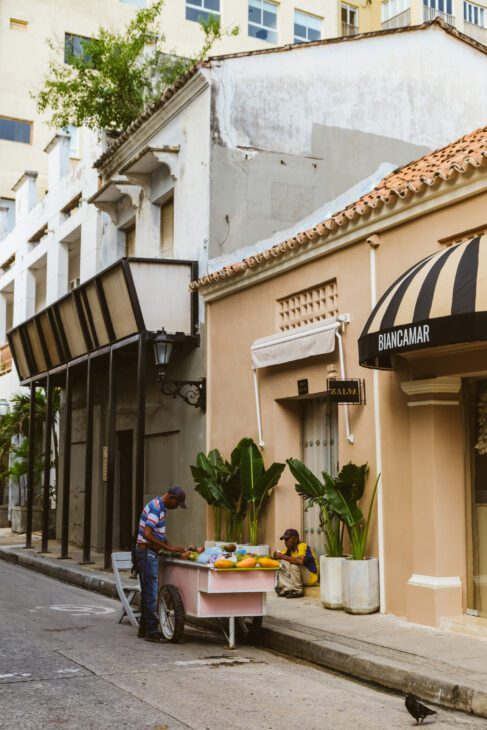

What to Expect with Money and Spending
Exchange Rate
The currency of Cartagena is the Colombia peso. Currently (June 2024), the best way to round the exchange rate is about 4,000 pesos to $1. (Take the Colombian price; divide by 4,000.) Some tours booked ahead of time will charge in American dollars, payable through Venmo. Though I’ve read American currency is accepted at some places in the city, we didn’t encounter that. And just to note, ATMs aren’t as ubiquitous as other major cities; use it when you see it!
Accommodations & Dining
Prices are all over the place, but for the most part, daily expenses will be less in Cartagena than in the US. Hotels and accommodations are on par with major US cities and range from budget to luxury. (For transparency, our 4-bedroom, 8-person Airbnb was just under $2100 for 8 nights; our one-night, unexpected stay at a hotel was $114 – and that was pretty discounted.) At mid-range restaurants, it’s on average $10-15 for a meal. Local beers are $1-2 and imported ones are at least double or triple that. Wine is the the most expensive, because it’s all imported. Street food is always cheap, as it’s mostly selling to locals.
Shopping
If you’re planning to shop, there’s also a huge range in prices. Cartagena does have many upscale boutiques where you’d pay higher prices, similar to what you’d find at a brand-name store like Banana Republic or Nike. You can find cheaper clothing and souvenir prices at markets and shops where the goods are mass produced. When it comes to the clothing, though, you’ll notice that the price reflects the quality. With the markets and street vendors, you can usually negotiate lower than the sticker or first-offered price!
Food Safety and Avoiding the Runs
Americans have been indoctrinated with a paranoia about consuming anything south of the border, especially the water, so I know it’s a question on the mind of many travelers. When it comes to a tropical lowland area like Cartagena, I think there may be more reasons for concern than negative stereotypes. Online debate swings either way; lots of folks say the tap water is fine, but most heed to proactive caution. Jugs of bottled water are cheap, and you can always find bottles for sale from street vendors. Cold drinks from restaurants are often served or made with ice, though, so you may be negating that precaution when you order a Coke. We bought bottled water, but that didn’t stop my digestive tract from rebelling halfway through the trip; it’s a toss-up.
There are lots of dining options throughout the city. Because Cartagena is such a tourist hub, you can find most any type of food, but its location and history brings a lot of coastal an Afro-Caribbean influence to its local cuisine. Seafood dishes are widely available and fresh, most often served alongside plantains and rice. Familiar Latin American street foods – arepas, patacones, deditos, empanadas – are a must-try. [A tour guide told us these prices would always be fair, because they’re typically for locals, not tourists.] Most restaurants had kid menus or would accommodate kid-specific dishes, off menu. If your accommodations are self-catering, you can shop at the Exito supermarkets for groceries, which is also very budget-friendly.
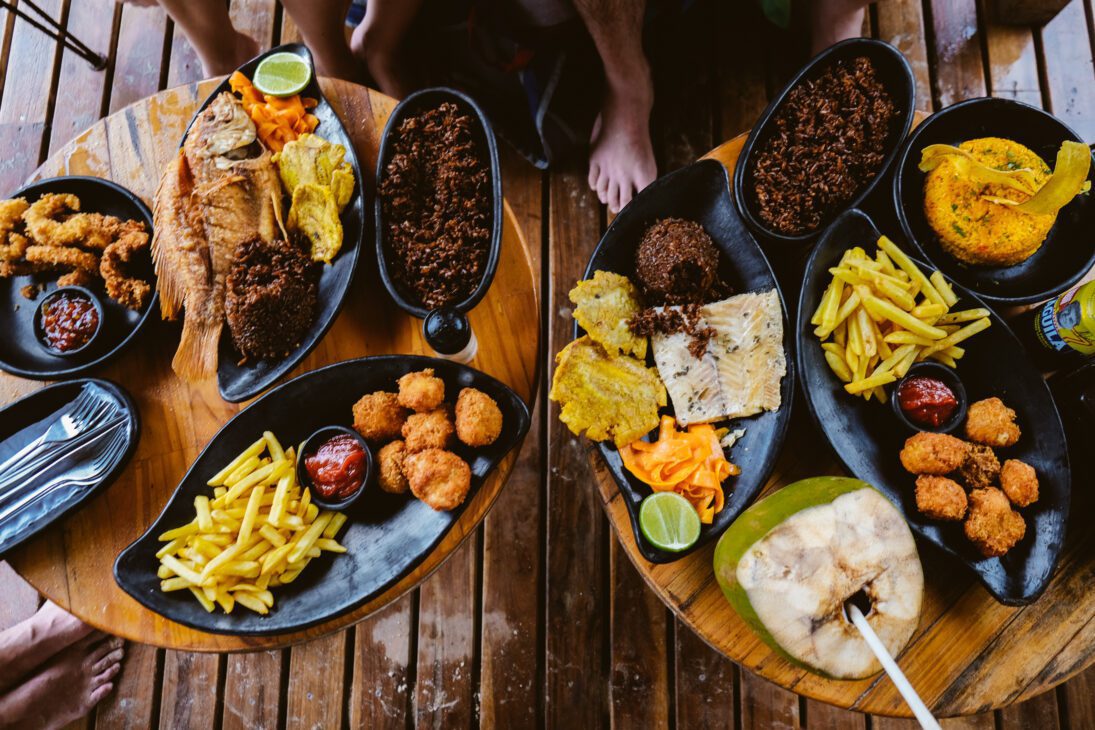
Traveling via Foot, Bus, Taxi, Uber, Motorcycle…
If you’re staying in the walled city or Getsemaní and have no mobility issues, make sure you pack good walking shoes! It’s a small area – to get from one corner of the walled city to the other would only take about 20 minutes – and walking is usually the quickest and easiest way to get around. For our 3-year-old, we used a the very best travel stroller in the world, and though the sidewalks aren’t the best for wheels, we made it work (lots of hopping between sidewalk and street) and we’d much rather have it than not.
Taxis are widely available and will often lightly honk as they pass by, in case you want a ride. Most rides within the city would be under 10,000 pesos; be sure to agree upon a price with your driver before your ride begins. We never actually used taxis, opting instead to use Uber. Not speaking very much Spanish, we were more comfortable using Uber regarding navigation, price, and safety. If you’re heading outside the walled city or Getsemaní, definitely use a taxi or Uber; it’d be a far walk in non-tourist areas, otherwise.
Have a plan for transportation into the city if you’re arriving through the airport. It’s only a 15-minute ride from Old Town, but drivers will love to entice you with “cheap” American prices for your first ride in Cartagena. ($40 is way expensive by local standards!) You’ll realize this with subsequent rides, especially when your commute back to the airport is 1/4 that first price, and you can just shrug it off as supporting the local economy.
There are buses in and out of city center, though we didn’t use any of them. And also, we have two kids, so I was definitely joking about the motorcycles – though you can hitch a ride on one through Uber!


